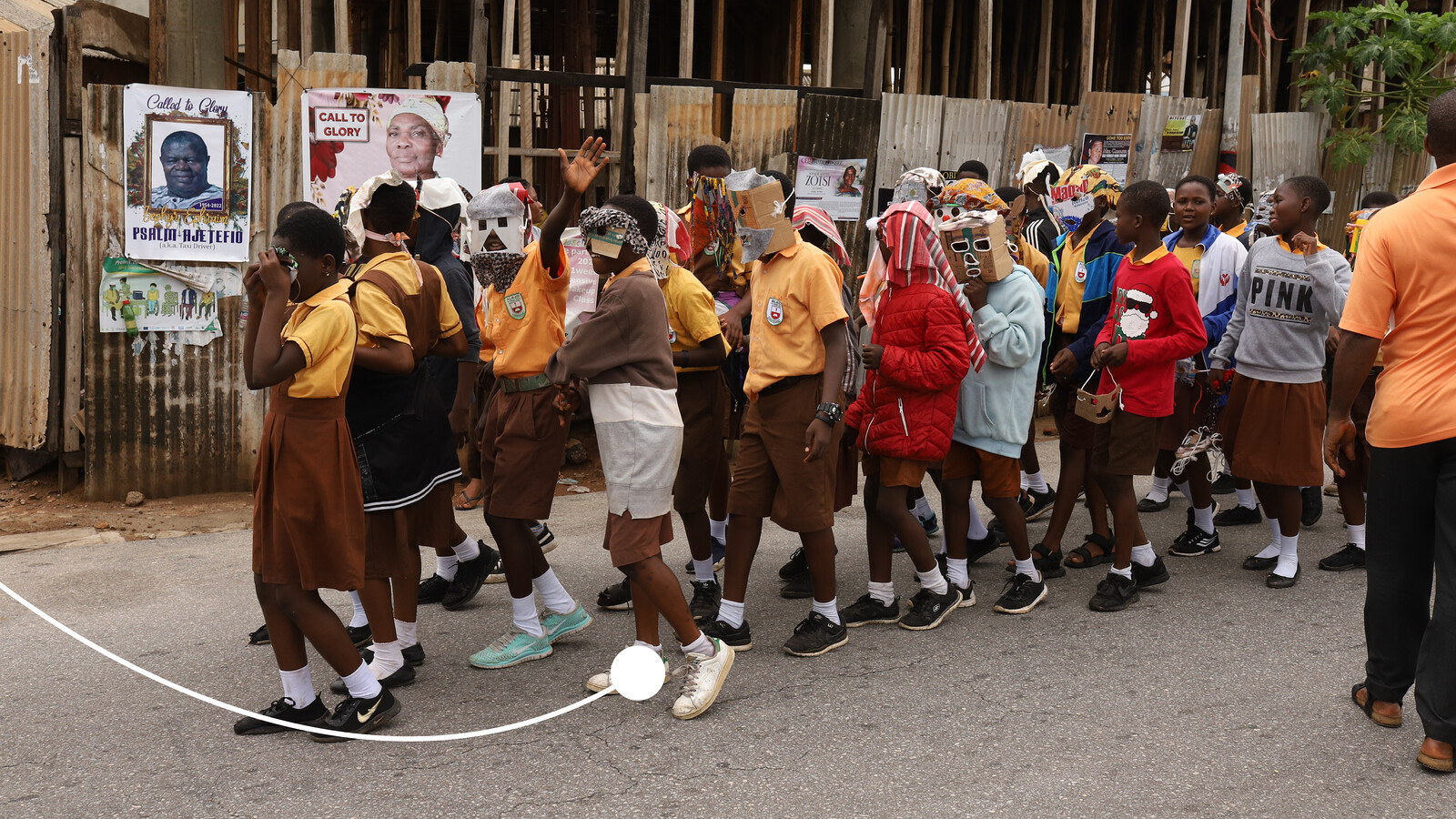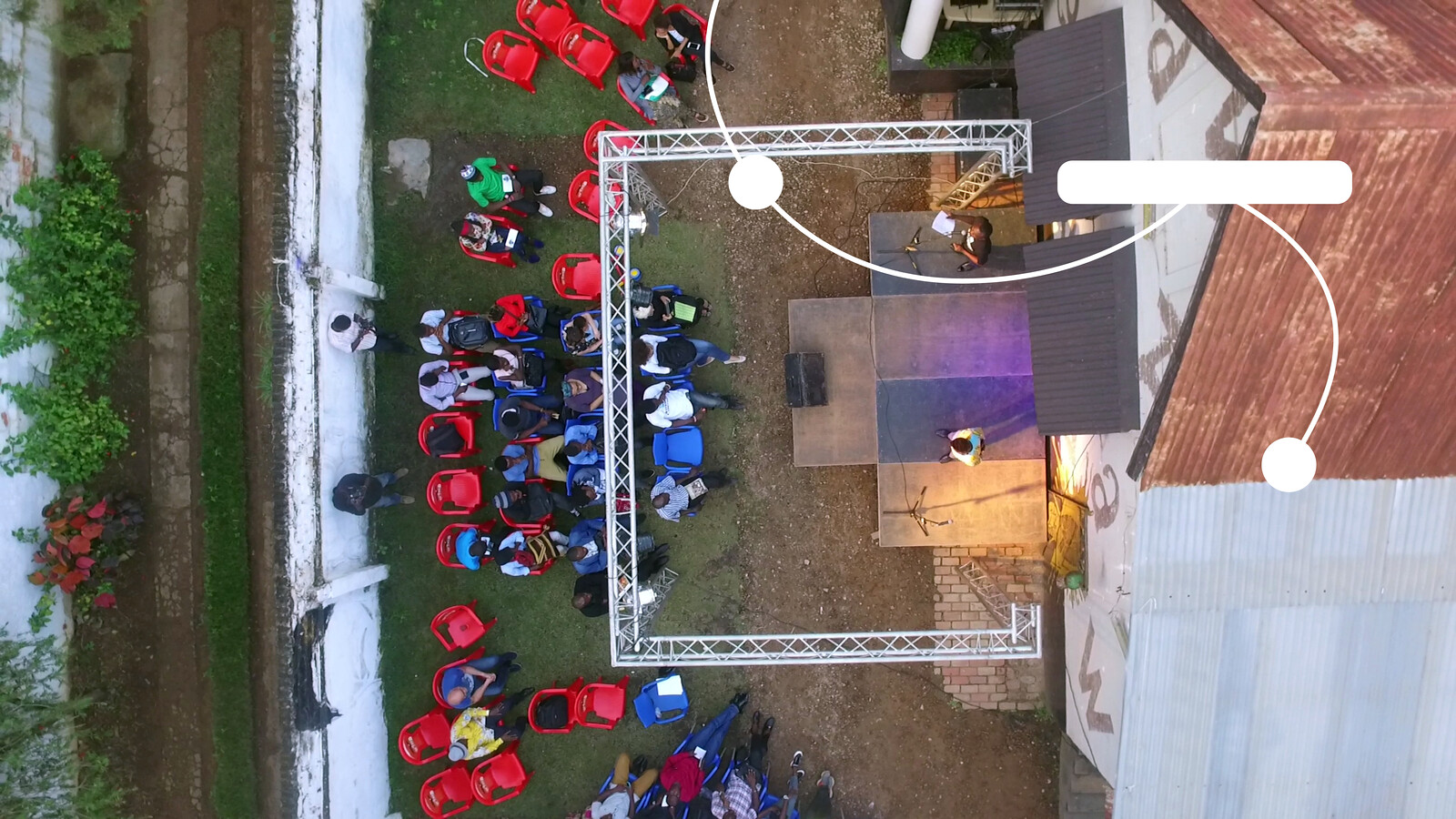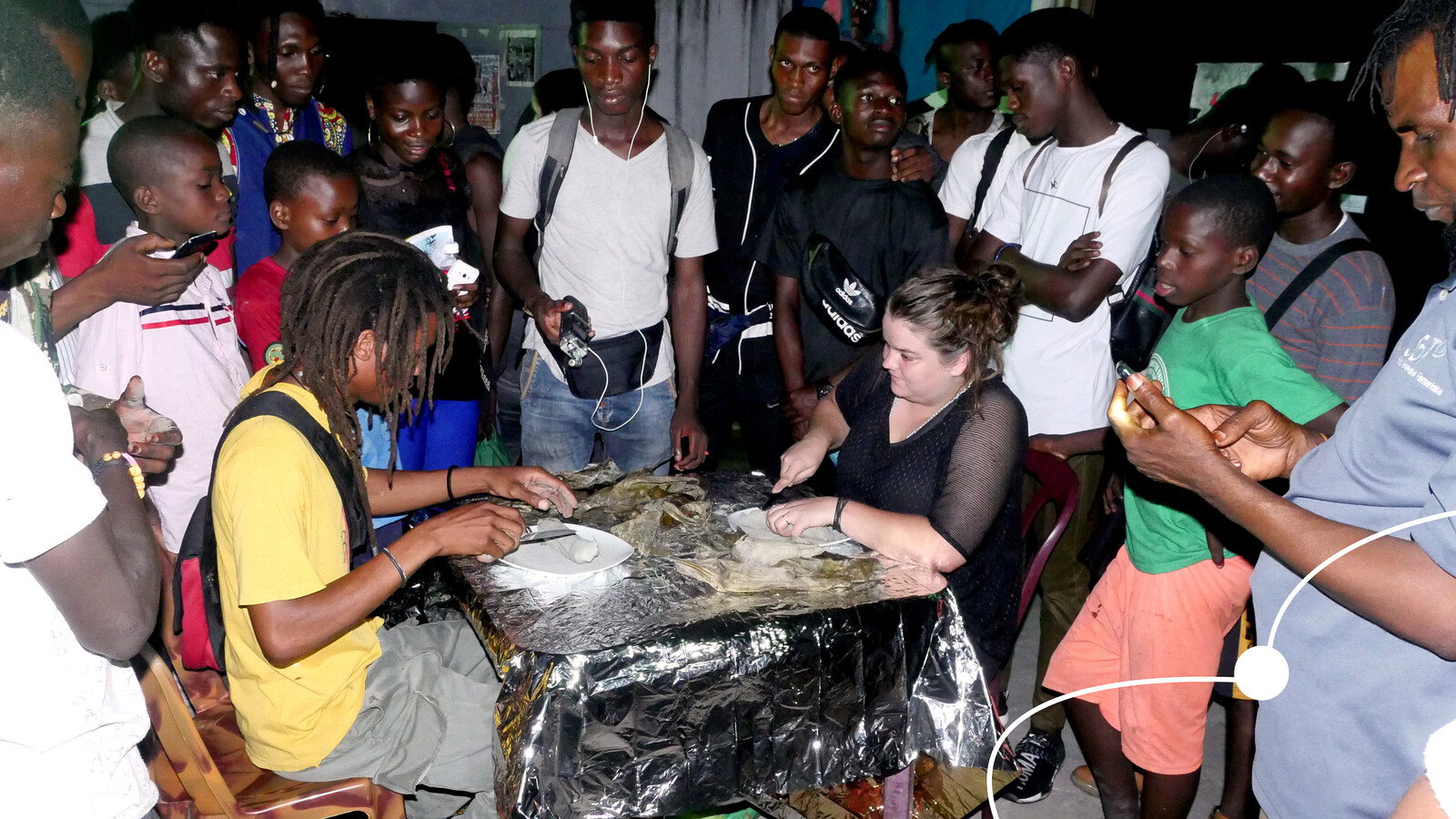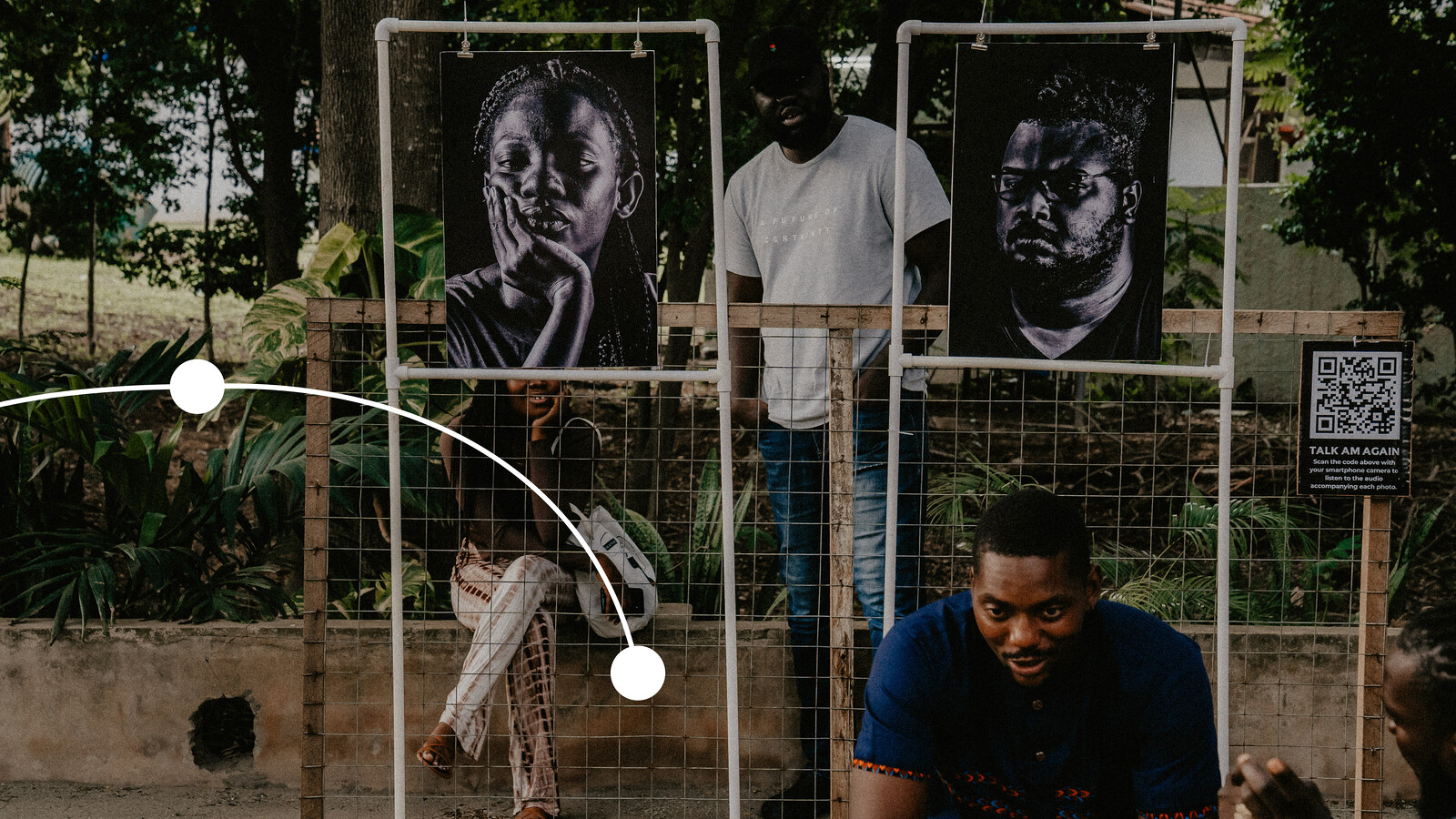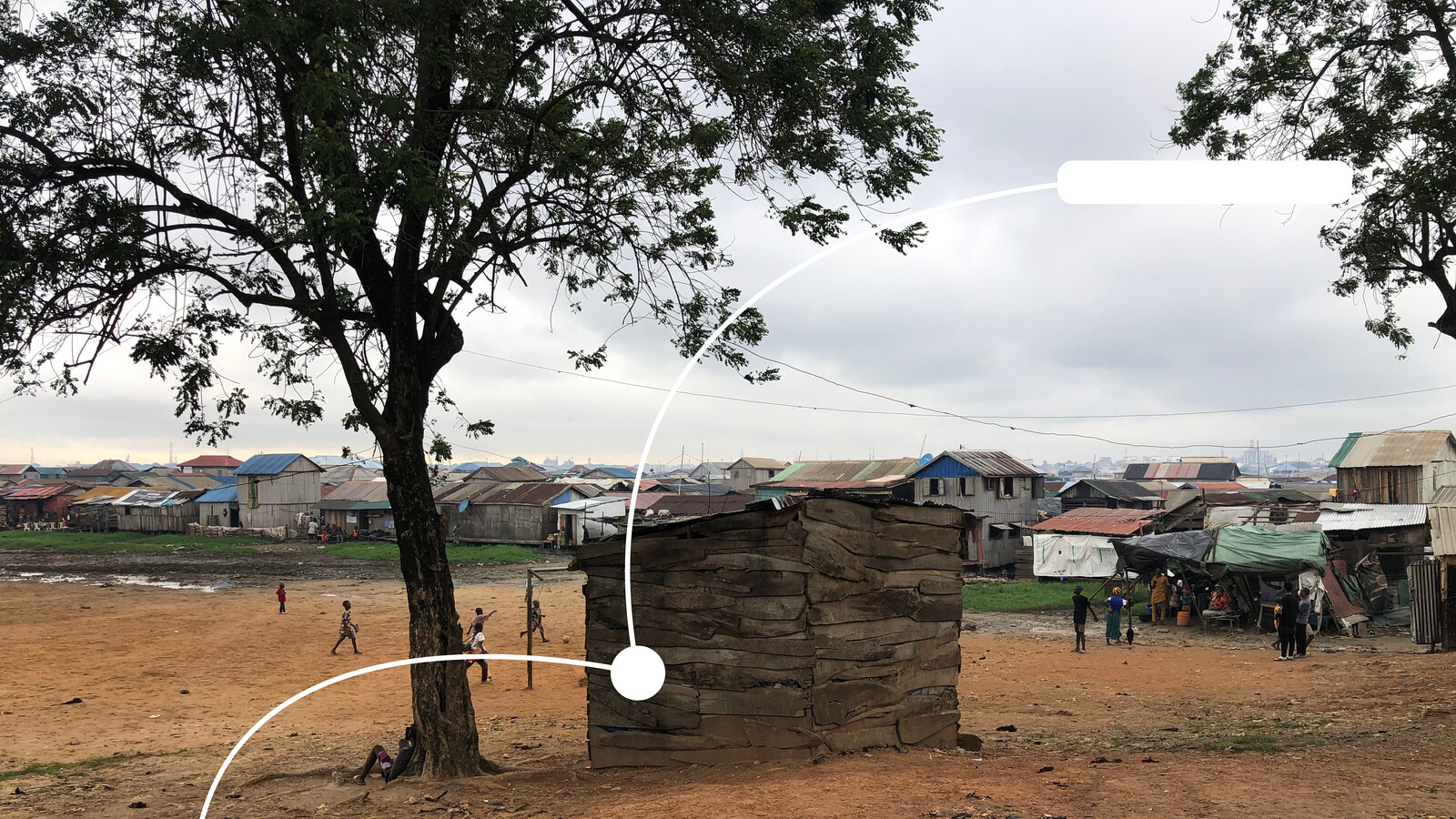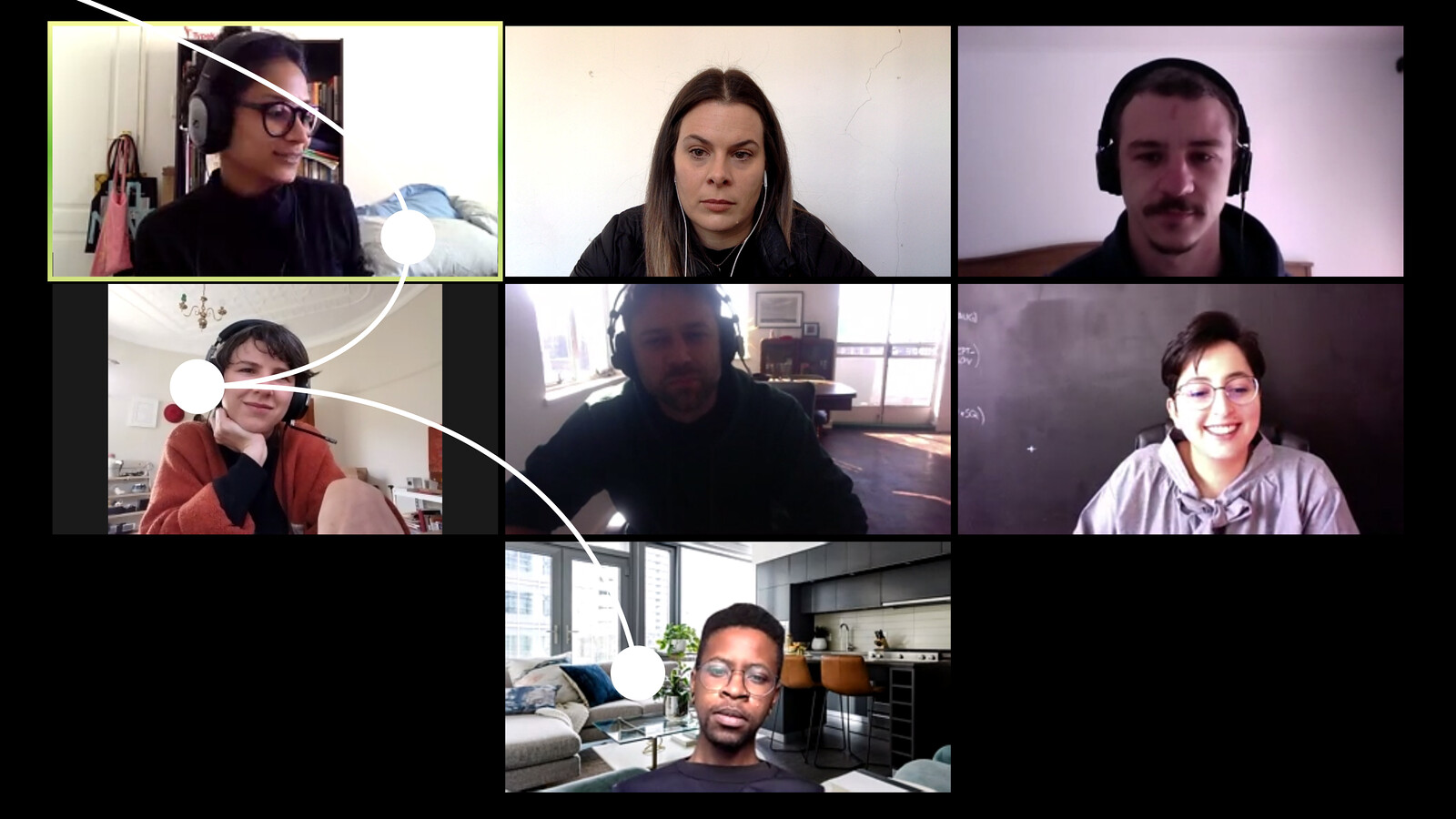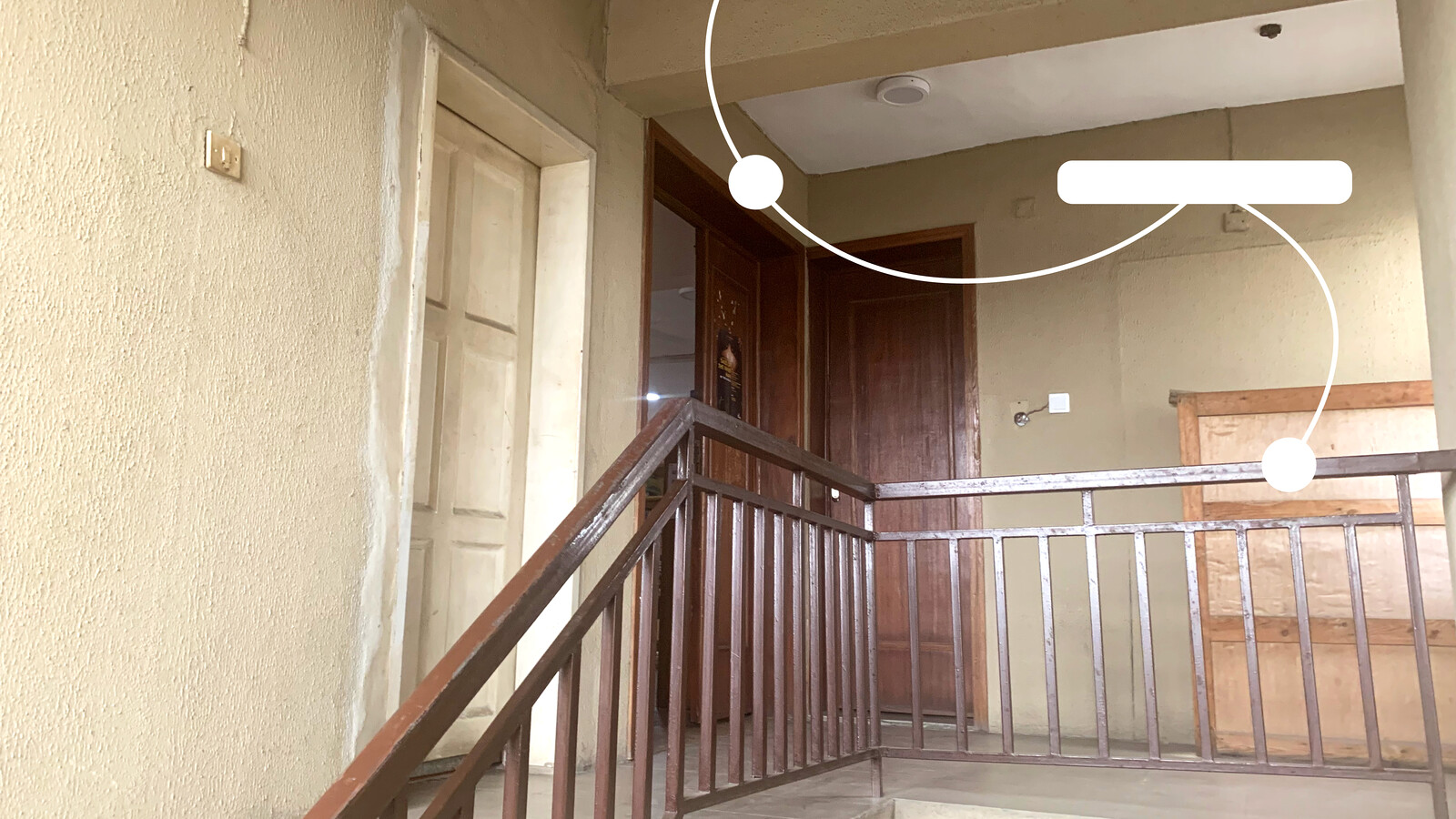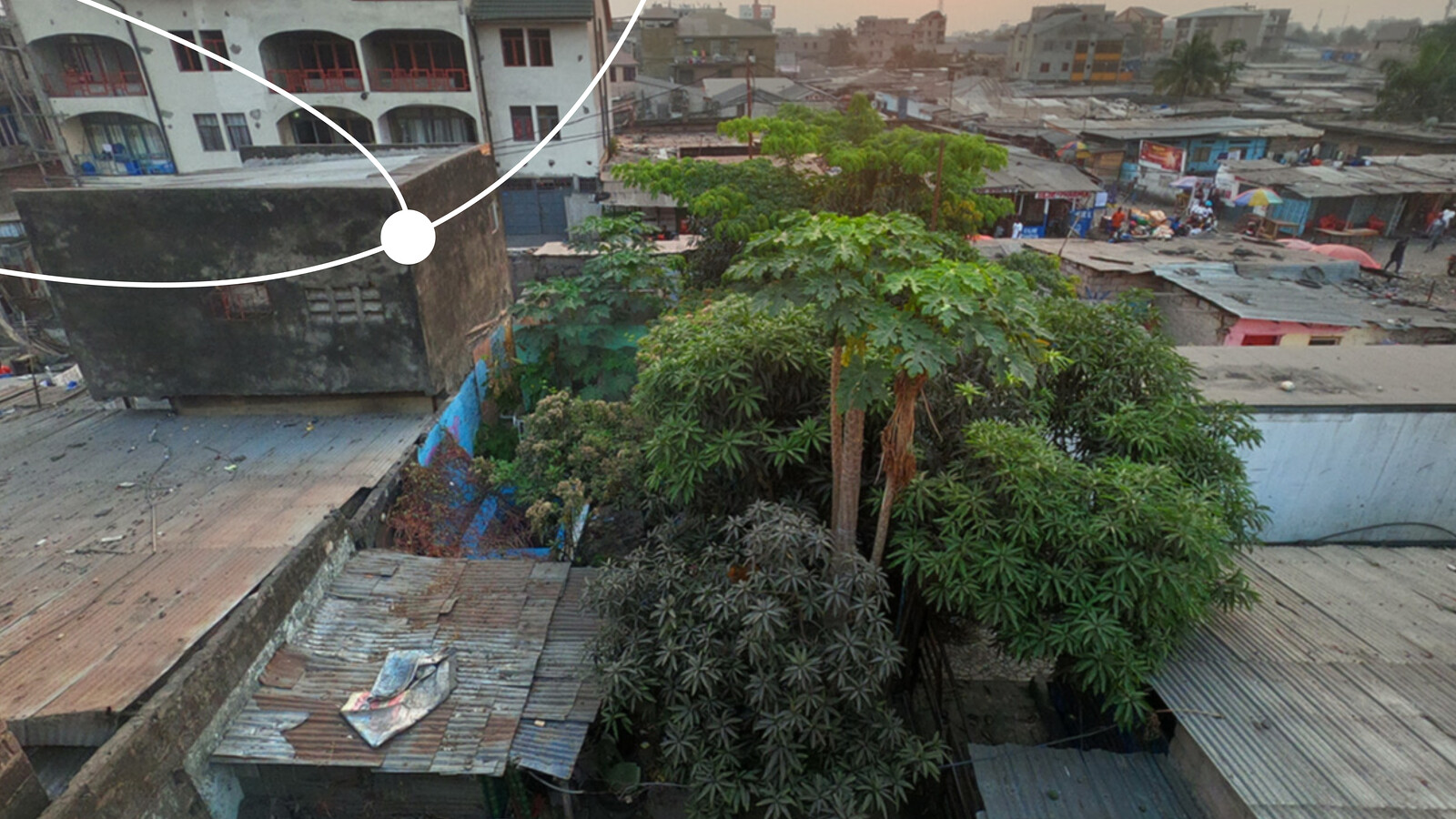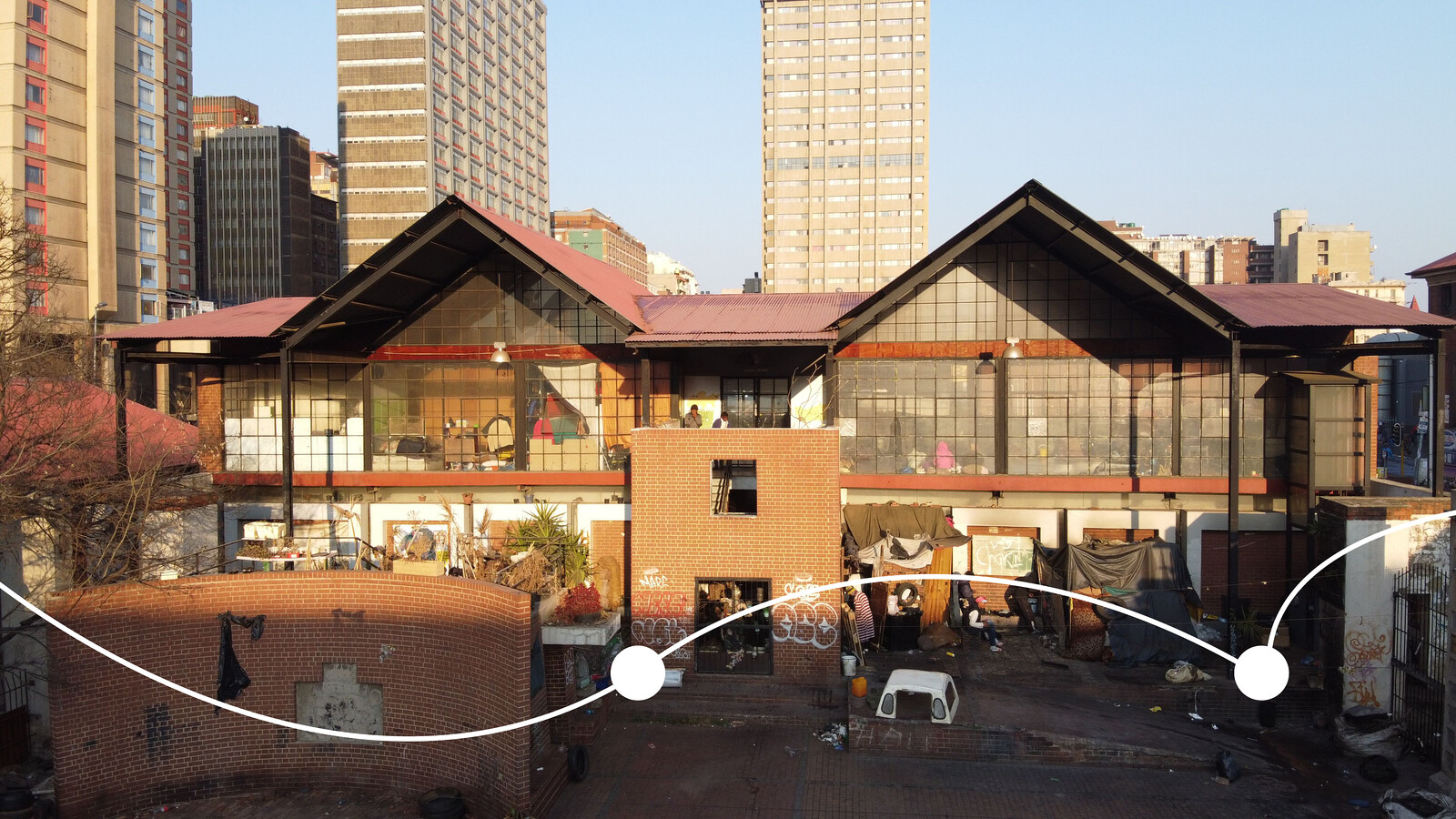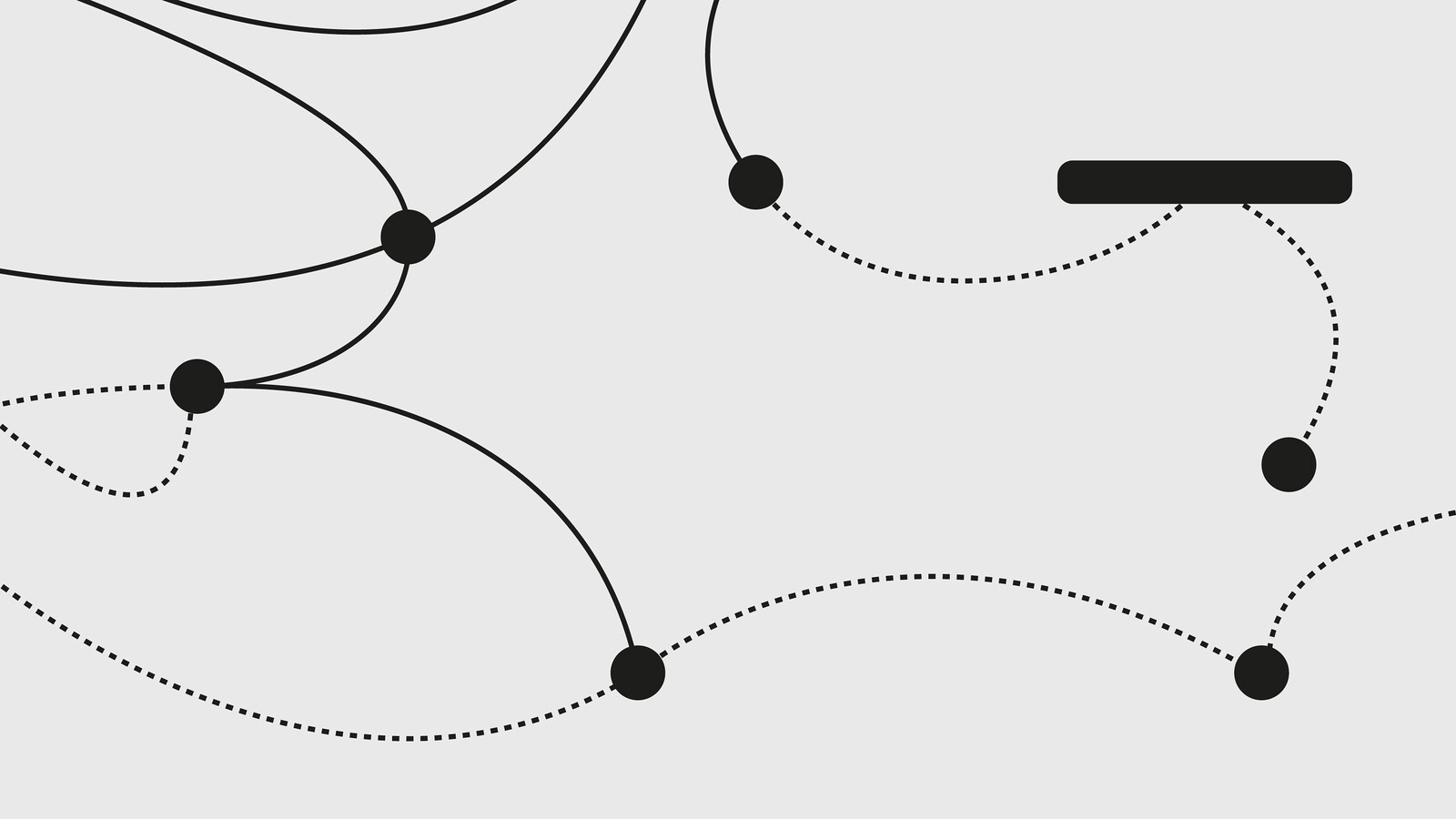It is almost mid-day on a mellow Sunday afternoon in Accra. It is September 4, 2022, the day our comrade and friend, Isaac Nana Osei Kwadwo (aka Ashanti immigrant) would be finally laid to rest in his hometown in Offinso, Ashanti Region, Ghana. On Saturday, September 3, the entire art community in Accra had gathered in the grounds of the W. E. B. Dubois Centre to mourn and eulogize Na’sei. Despite the tears and sighs from the previous day, the mood is a bit lighter on this rather unintended afternoon. We’re back in the Dubois Centre.
We have come to tidy up after the memorial service and meet up with Laurel Richardson, and artist, academic, and one of the guest facilitators in the upcoming 2022 edition of Exit Frame’s CritLab in Tamale. Upon arrival to the Dubois Centre, we serendipitously bump into Professor Linda Dey, a former lecturer of Laurel’s, who is also known to Ato Annan and Adwoa Amoah from earlier engagements at the FCA. This is how we all settled down in front of the FCA office, to have an “intentional conversation” about art, about life, about spirit, about memories, about connections and about our shared humanity…
A few weeks on from this chance meeting in Accra, we receive unfortunate news of the passing into glory of Mr. Seth Dei, one of the founding members of the Foundation for Contemporary Art (FCA), Ghana. Mr. Dei, an avid art collector and patron of many art initiatives in Ghana—his own collection having formed the basis around which the Dei Centre was established—sat on and spoke at the panel at the seminar that marked the launch of the FCA in November, 2004. Also present at this launch event were Professor Joe Nkrumah, formerly of the National Museum, Accra and Mr. Nat Nunoo Amarteifio, former mayor of Accra, now all of blessed memory.
That one-day seminar, with the theme “Facing the Mirror: Does Contemporary Art Reflect Contemporary Society?” opened with the launch of FCA by the late Professor Joe Nkrumah and Virginia Ryan, who were co-directors at the time. It was held at what was then the Busy Internet office in Accra. The High Commissioner for Canada, H. E. Mr. Donald Bobiash, introduced a film entitled “Recalling the Future: Art in Contemporary Africa,” which was screened at the event. Later, an open discussion headed by a panel of artists and allied practitioners followed, which included the director of the Kokrobite Institute, Renée Neblet; architect and author Lesley Lokko; Ghanian contemporary artists Kofi Setordji, Godfried Donkor, and myself, Bernard Akoi-Jackson. Among the many activities that marked the day was an exhibition of artwork by Empress Olivia, an artist who was based in Kokrobite at the time. On this day the website of the FCA was launched, too.
Since its founding on November 11, 2004, FCA, Ghana has been a front runner in connecting Ghanaian audiences to contemporary art and, at the same time, inspiring change in the general perception of art. The foundation is membership-based and has been run by artists ever since its founding. For over two decades, FCA, Ghana has held exhibitions, seminars, screenings, and artist workshops to raise the profile of contemporary art in Ghana. Collaboration has remained a central ethos of FCA, Ghana, having worked together with renowned art and associated institutions. The physical location from which FCA operates is within the W. E. B. Dubois Centre for Pan-African Research, located on the First Circular Road in Cantonments, Accra. This location is not only the office where the association’s administration happens, but also serves as an experimental exhibition space and reference library on contemporary Art.
So, when on that mellow Sunday afternoon in Accra, on a rather unintended day, we serendipitously met up in front of the FCA, Ghana offices at the W. E. B. Dubois Centre in Accra, with a whole lot of our sisters from the Diaspora and other kindred spirits from around the world—the day after the entire art community in Accra had mourned our brother Isaac Nana Osei Kwadwo—it was nothing far from what FCA, Ghana has been doing for nearly two decades. Over all these years, FCA has held true to its founding slogan, functioning as “creative catalysts for viable art worlds.” In this same spirit, many months later, it is late afternoon on a Sunday at the FCA, Ghana office in Accra. We have met again, this time, four of us: Adwoa Boakyewaa Amoah, Ato Annan, Fatric Bewong, and myself, as though facing the mirror all over again…
Bernard Akoi-Jackson: First and foremost, you are all welcome to this rather brief conversation, if we can describe it so. Adwoa Amoah and Ato Annan, co-directors of FCA, Ghana and Fatric Bewong, artist and regular collaborator with FCA.
Adwoa Boakyewaa Amoah: Thank you Bernard for having us.
BA-J: And thank you too, for having me here at the W. E. B. Dubois Centre.
Ato Annan: Thanks, Akoi, great that we are finally getting to have a sit down to chat.
BA-J: A brief moment out of all our “busy” schedules is something to treasure, isn’t it?
[collective laughter]
Fatric Bewong: Indeed, it is a precious moment… Life gets so hectic these days, one cannot even mention the traffic situation in Accra! But this moment, right here, is one to cherish.
BA-J: And it has been long in coming, hasn’t it? Many exciting events have come up since we scheduled to meet a few months back. In the in-between, Ato and Adwoa, you have curated an exhibition “If we’re happy in our dreams, does that count?” at the ifa Gallery in Stuttgart, Germany, and Fatric, you were one of the artists in this show. We will get back to all those projects a little later in our conversation, but for now, let’s begin with the Foundation for Contemporary Art, Ghana. You have been in existence for close to twenty years now. Two decades is quite a long time. Can you speak to any particular moments in the life of FCA so far that indicates the impact it has had on the Ghanian art scene?
AA: There are many things that have become quite commonplace in the Ghanaian art scene that were nonexistent some years ago. We can speak of such things as art talks and crits, public art events that focus on communities, projects that combine art, urban space, and architecture, just to mention a few.
FB: Yes, I remember one of the very first such talks I attended. It was one in which you, Akoi, you gave a talk at the Goethe-Institut, under the auspices of FCA. The title was something like…
BA-J: Wasn’t it something like “Do art and not dabble in witchcraft”?
AA: Yes, yes, that was a good one… I must say, most of what you were saying at the time seemed rather abstract and all that, but it went down quite well at the same time.
BA-J: Or disastrously. [laughing]
AA: No, no, rather on the contrary, that art talk made quite an impression on all who attended.
ABA: And then you Fatric, you also presented your work right here at the FCA office
FB: Yes I was quite nervous at the start, but as you know, back in art school (KNUST), we did a lot of seminar presentations at the Department of Painting and Sculpture, so I eventually zoned in on the excitement. People were really engaged.
ABA: Yes, we can comfortably say that we initiated quite a lot of the activities that have become mainstays, at our inception, and now the art scene is awash with many iterations of them…
BA-J: So, in this sense, what have been some of the most notable legacies of the FCA?
ABA: Well, FCA has established itself as a support structure for artists and their publics. We are arguably one of the early catalysts that has propelled contemporary art practice in Ghana. Therefore, a lot of recognition for artists both locally and internationally has had some incubation with FCA, Ghana.
BA-J: Kindly share with us institutions, individuals, and bodies with whom you have collaborated over the years, and a selection of projects you have worked on that have contributed to the FCA story.
ABA: Without hesitation, I will readily mention Bisi Silva, now of blessed memory, but founder of CCA-Lagos and part of the Global Crit team with Kianga Ford and Shane Aslan Selzer. Without a doubt, Bisi offered us a new critical direction towards the work we were doing here in Ghana right from our first encounter with her in December 2010.
AA: She became a mentor to us not just as practitioners, but also as administrators of an arts organization.
ABA: Through her, we also met the Global Crit team in 2011, and fast forward to 2013, together with her, FCA organized and hosted the second Àsìkò Art School in Ghana. We also co-organized Global Crit Clinics three times in Accra between 2012 and 2014.
AA: Many of the artists working on the continent and in Ghana today with a critical practice benefited directly or tangentially from these projects.1
ABA: Guest presenters for the Global Crit Clinics have included yourself Bernard, Kwasi Ohene-Ayeh, and Adomaa. A direct result of these steps is the current Critlab project in Ghana, which is entering its fourth year now.2
BA-J: You have not always been co-directors of FCA, Ghana. Can you say when you took over the reins, and what changes (if any) have marked your specific tenure?
AA: I became actively involved in FCA, Ghana in 2007, and Adwoa was already with FCA, Ghana by 2005. By the time we took over the leadership, we started to make a shift in the programming of the FCA project called “Art in the garden.” It was designed to offer artists alternative venues to show and share work like installations or large sculptural work that would not typically fit within the context of the galleries that operated within the city of Accra at the time. Between 2009 and 2010, we chose to move these events from the private gardens of expatriates and diplomats, where they were mostly held in locations like cantonments, to various public areas like Jamestown in Accra, Freedom Park in Koforidua, and the Busua Community in Takoradi.
ABA: The goal was to genuinely democratize access to both artists and the general public.
AA: The new format, which we referred to as “Art in Public Spaces,” also sought to demystify the artistic creation process. Through these sorts of initiatives, we continually visited communities such as Jamestown, where we worked extensively with artists and members of the local community to facilitate the creation of murals, installations, and site-specific sculpture. One outcome of this was the Chale Wote Street Art Festival, which we co-ran and served as the Visual Art coordinators from 2011 until 2015.3
BA-J: What operational strategies have you devised over the years to sustain the relevance of FCA in the changing context of the Ghanian art scene?
ABA: We operate in a scene where there is very little to no public funding for the arts. This means that as a not-for-profit institution, it is very easy to have financial constraints. As a result, we have maintained a strategy of collaboration with institutions and individuals. This continues to expand our network, exposing us to many innovative ways of getting work done.
AA: In a similar way, we leverage the solidarity economy that exists in our scene. People provide labor, time, and knowledge to support ideas and projects, and when the need arises, they get support with their own projects in equal measure. Building good and healthy relationships with collaborators has always been central to our operations. It helps us stay firmly grounded in our core mission of supporting artists. Most of the time, we offer free consultation and support for institutions and individuals. In these ways, we get projects done without financial constraints becoming a hindrance.
ABA: This is a template for survival that has inspired many institutions and artists in the Ghanaian scene.

Akanmaje Community Youth work with Joseph Kola in his studio in Nungua as part of “Art in Public Spaces,” 2010. Photo: Adwoa Amoah.
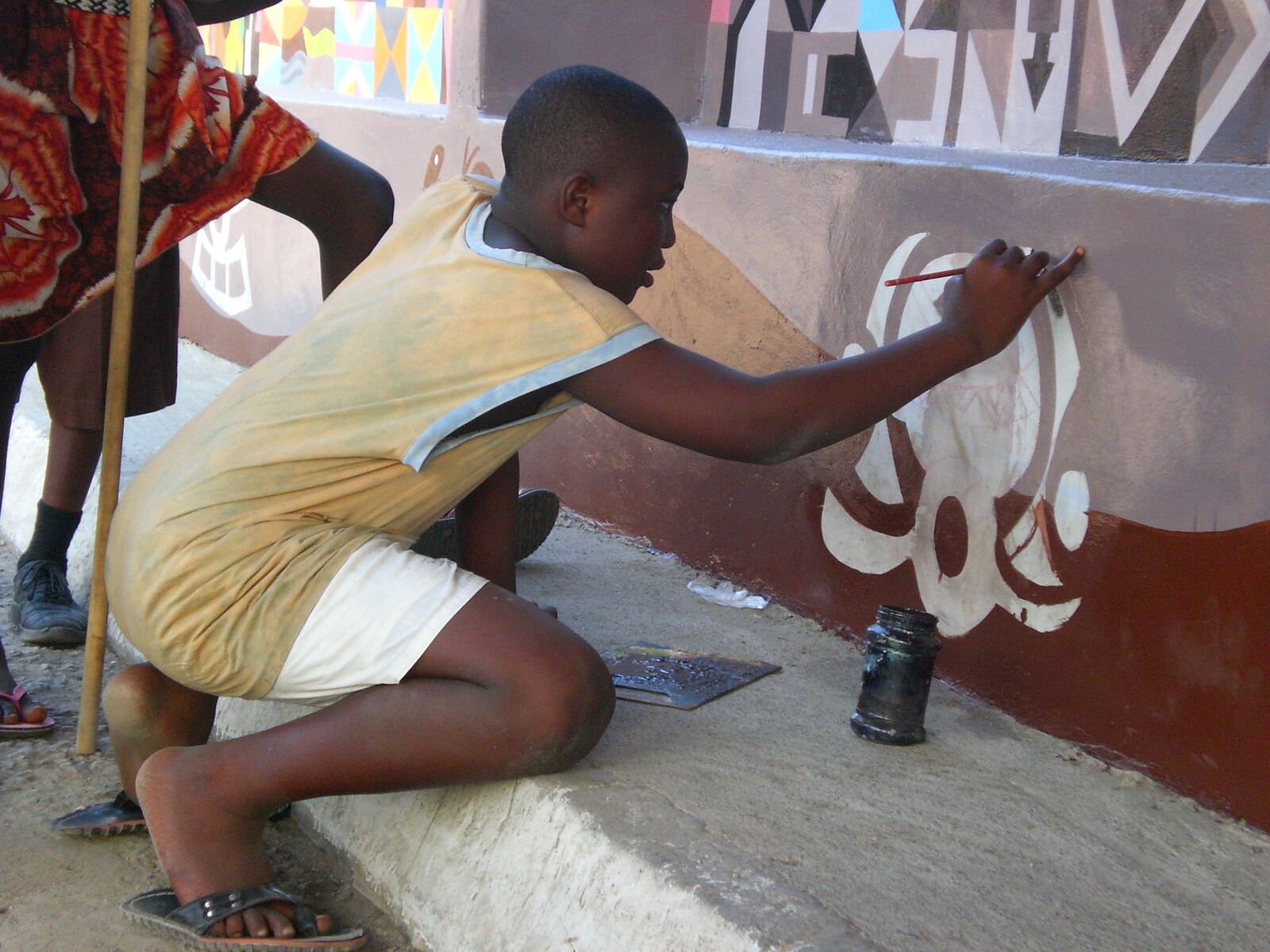
Mural at Akanmaje as part of “Art in Public Spaces,” 2010. Photo: FCA-GH Archives.

Installation by Artists and the Akanmaje community in Jamestown as part of “Art in Public Spaces,” 2009. Photo: FCA-GH Archives.
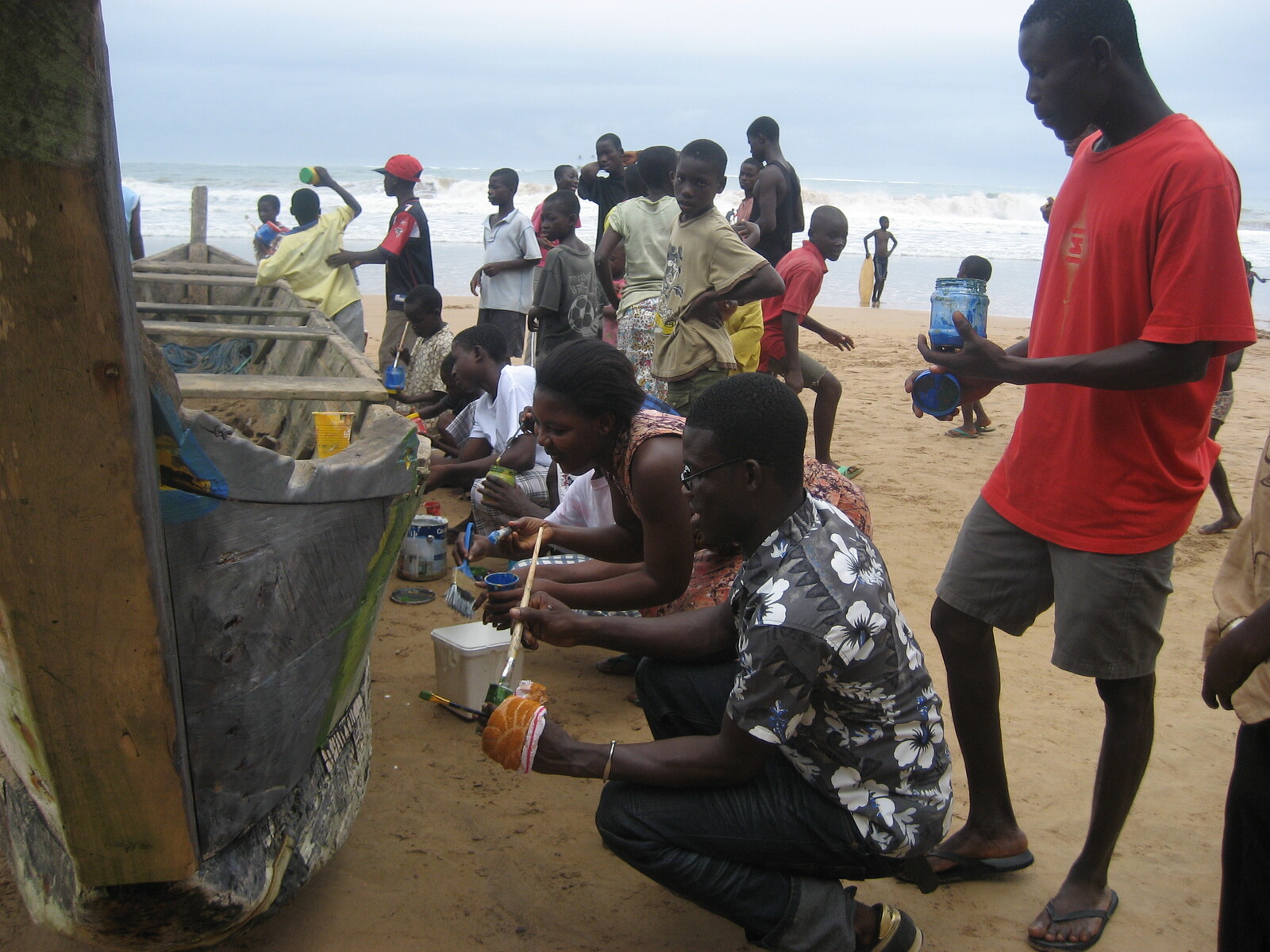
Artists and Busua community in the Western Region of Ghana as part of “Art in Public Spaces,” 2009. Photo: FCA-Gh Archives.
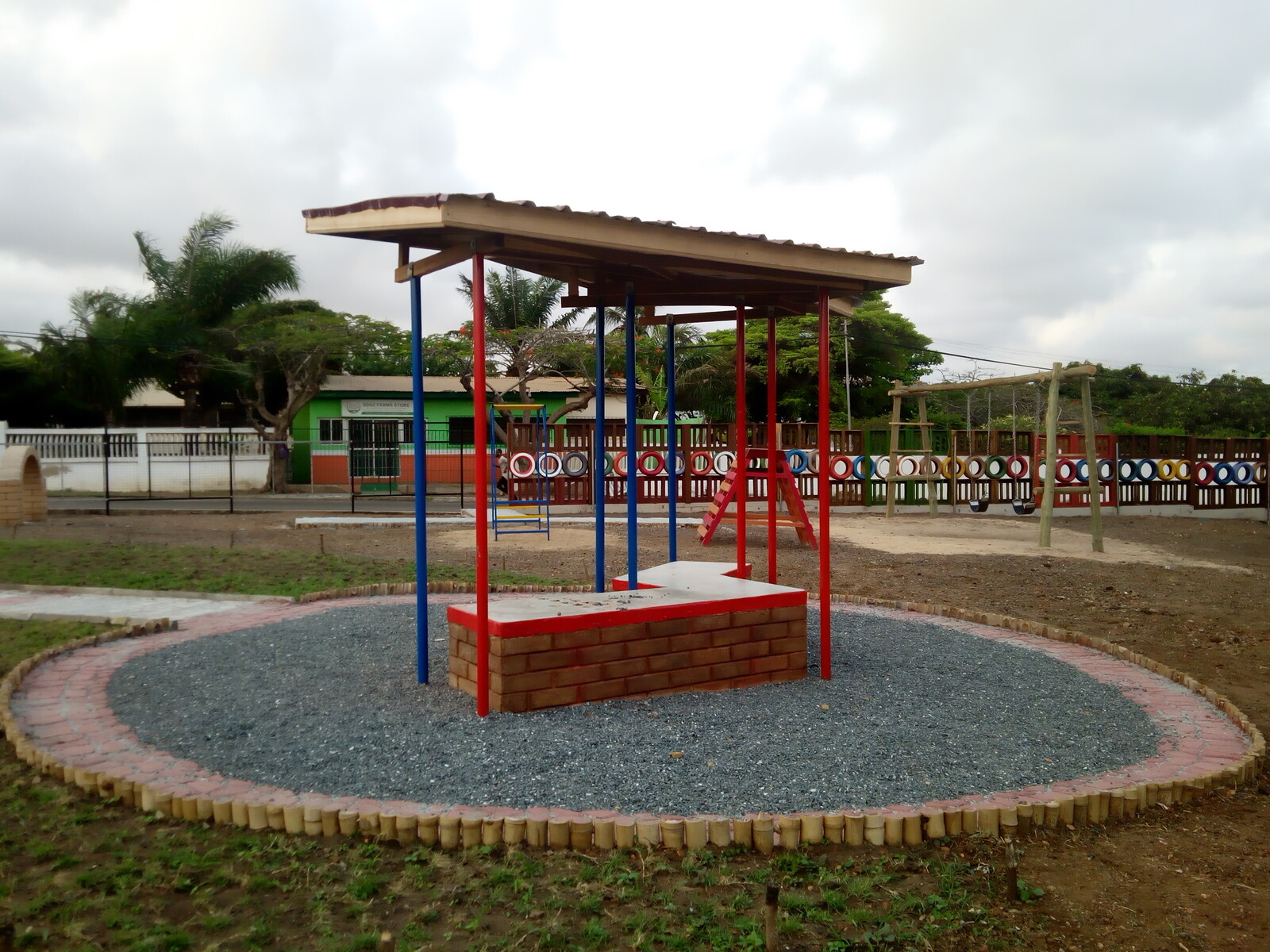
Teshie Community Park, 2018, a collaboration with Mmofra Foundation. Photo by Adwoa Amoah.
Akanmaje Community Youth work with Joseph Kola in his studio in Nungua as part of “Art in Public Spaces,” 2010. Photo: Adwoa Amoah.
BA-J: To this end, what is FCA’s status/position within the Ghanaian art ecosystem?
ABA: FCA, Ghana has been positioned as the go-to place for support for a lot of artists. Let me say here that we do not have hard cash, but what we are is really a catalyst, which facilitates access in the forms of community and knowledge sharing. If you need a place to hang out, meet other artists, exchange ideas, do research either through our library resources or in a conversation, that’s us.
BA-J: Being centrally located within the Dubois Centre in Cantonments, in Accra, how has your location been an advantage (or not) to the projects that you do?
AA: The Dubois Centre is considered a very important space within Ghanaian history, with regards to our struggle for independence and post-independence/post-colonial existence. It is where in 1961, at the invitation of the first president of Ghana, Dr. Kwame Nkrumah, W. E. B. Dubois stayed when he left the United States and came to Ghana to embark on the project Encyclopedia Africana. The space we are in, the compound, the complex, is where he lived until he passed away. When he passed, he was initially buried in the Christianborg Castle at Osu in Accra. But in the 1980s, people within the Ministry of Arts and Culture decided it was important to move Dubois’s remains from the Castle to a “proper,” memorial burial place. And so, his mortal remains were exhumed and moved back to where he had lived when he came to Ghana. A tomb was built for him within the compound, and his residence, the actual house he lived in, was turned into a museum. This is generally where we’re situated. The complex also has a library, comprising Dubois’s private library (books he had and read) when he lived in Ghana, and a more general, public library.
BA-J: How did you end up in such a space?
AA: We came into this space based on several conversations that had taken place between the founders of FCA, Prof. Joe Nkrumah, Virginia Ryan, and Sekou Nkrumah, who was the acting director of the Dubois Centre at the time, in 2003. Other people with common interests and art groups comprised of musicians, actors, and crafts people were also housed within the large compound. The idea was that FCA would provide curatorial support for the Dubois Centre. As you rightly mention, the Centre is located in Cantonments, which is again, a very important space within the city, if one considers how the city of Accra is laid out. Given how the city was built and grew, Cantonments became one of the places where a lot of colonial officials resided. A lot of those colonial buildings built to accommodate colonial officials still remain.
ABA: And when power shifted in the immediate post-independence period, Ghanaian civil and public services began to house their officers in Cantonments.
AA: Cantonments has the military barracks of Burma Camp in close proximity; a lot of embassies and diplomatic missions have their residencies located in Cantonments. One other point of interest within this part of Accra is the abundance of Neem and Mahogany trees that were planted by the colonial establishment. Neem was brought in from India because it was believed to be medicinal and could serve as a mosquito repellent to fight against Malaria, which was common in Accra at the time.
BA-J: But also because Neem provided good shade, right?
AA: Yes, precisely. There are Neem and Mahogany trees in Cantonments that are over a hundred years old. Thus, within the urban setting, this is where you have some of the oldest trees.
ABA: This is not to rule out the prior existence of trees that are endemic to the tropical conditions of Accra itself like Silk-Cotton trees and Baobabs.
BA-J: Of course, of course…
AA: So, there are a lot of old trees in Cantonments, and in the Dubois Centre, some still stand. Cantonments is also close to Labone to the southeastern, it is close to Osu to the south. It is close to Kwame Nkrumah Circle to the west…
ABA: Cantonments is close to Kotoka International Airport, Airport Residential area, Legon, and further north to Madina, Adenta, and so forth.
AA: Cantonments is positioned as a great conduit for commuters from the surrounding settlements that would have housed most of the people who provided domestic and auxiliary services to the then-colonial households of Cantonments.
ABA: I think the 37 Military lorry station/transport terminal also positions Cantonments as a hub for travel, locally and internationally. From the 37 Station, you can commute to any part of Accra.
BA-J: You mentioned that W. E. B. Dubois was re-interred close to the Dubois House in Cantonments. Can you speak to the design of the tomb? Here I’m thinking of the architect or architects who would have worked on it…
AA: To the best of my knowledge, the design of the tomb was done by two architects. I know Ralph Sutherland was one. But before I answer that, I want to go back to the idea of the Dubois Centre being centrally positioned. The connections changed over time. As Cantonments grew and had many more diplomatic missions move in, and with the rise of a lot of luxury apartments, vehicular and human traffic began to change too. Suddenly, certain types of public transport could no longer commute the routes through Cantonments. Or, at least, their frequency became even more limited, so much so that now, the erstwhile easy flow of commuters to let’s say Labone via Cantonments from 37 Station becomes increasingly difficult. This meant that you could no longer access some of the streets of Cantonments without private transportation. One really had to have some business to do in Cantonments before plying those routes. This drastically changed the class demographic of the space. And since a lot of the diplomatic missions have not only their residencies but also consular sections located at Cantonments, you’d have streams of visa applicants traveling into these areas periodically.
ABA: This shows the changing roles that the space has had to go through over the years.
BA-J: You have somehow chronicled the colonial situation, the post-independence situation, and now the new situation of gentrification, where the movement of people has become restricted. But masses of people still do move in and out of this space. How have the programs or projects that FCA has initiated brought in a bigger mix of people who would otherwise not have had any business coming hereabouts?
AA: For us, the FCA space at the Dubois Centre is also our meeting place. The administrative office is here, as well as our library of books on art and the like, which can be transformed into an exhibition space from time to time. We do a lot of our activities here, using both the indoors and outdoors. But it is also because our programs are particularly engaging to people of all ages and demographics. When we have events, people from all walks of life come in. FCA is constantly drawing people of varying interests and concerns. But apart from this, a majority of our projects actually happen in locations dotted around the city and beyond. This keeps our members and audiences coming to this specific part of the city and beyond.
ABA: The Centre itself has also transformed from being a chiefly cultural space to becoming even more of a social space, where weddings, parties, church meetings, even pop-up flea markets have been held. This has also maintained the movement of another kind of public through the grounds.
AA: The space has always been multifunctional, so different things happen here simultaneously.
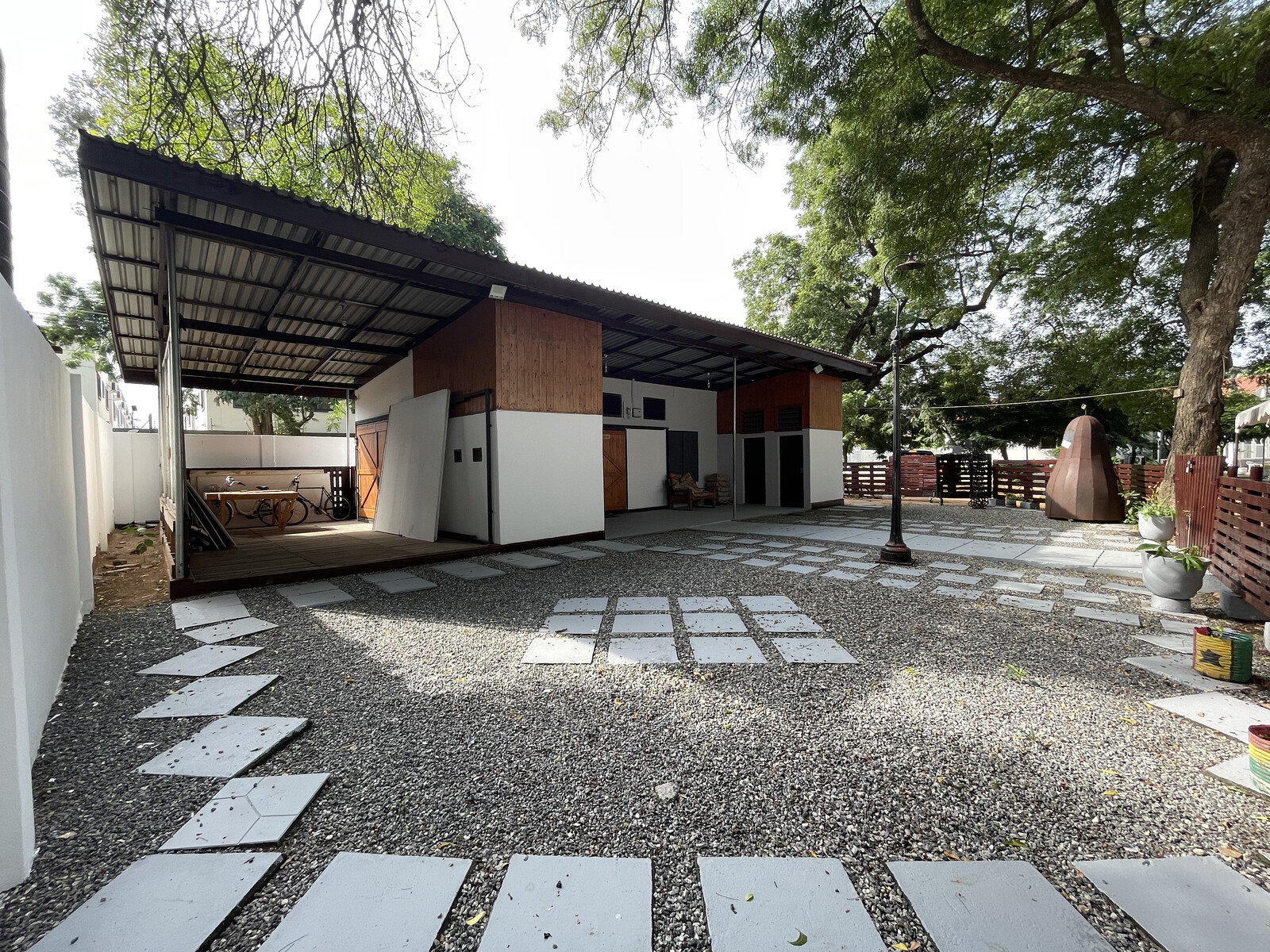
FCA Ghana Office and Research Library, 2023. Photo: Abbey IT-A.

Artists hang out at the office during Okuafo Pa Exhibition by Rita Mawuena as part of Pa Gya! A Literary Festival in Accra, 2021. Photo: Adwoa Amoah.

Open Studio with Godelive Kasangati Kabena at FCA. Pool tank, light created by the resin cube with menstrual blood. Photo: Abbey IT-A31.
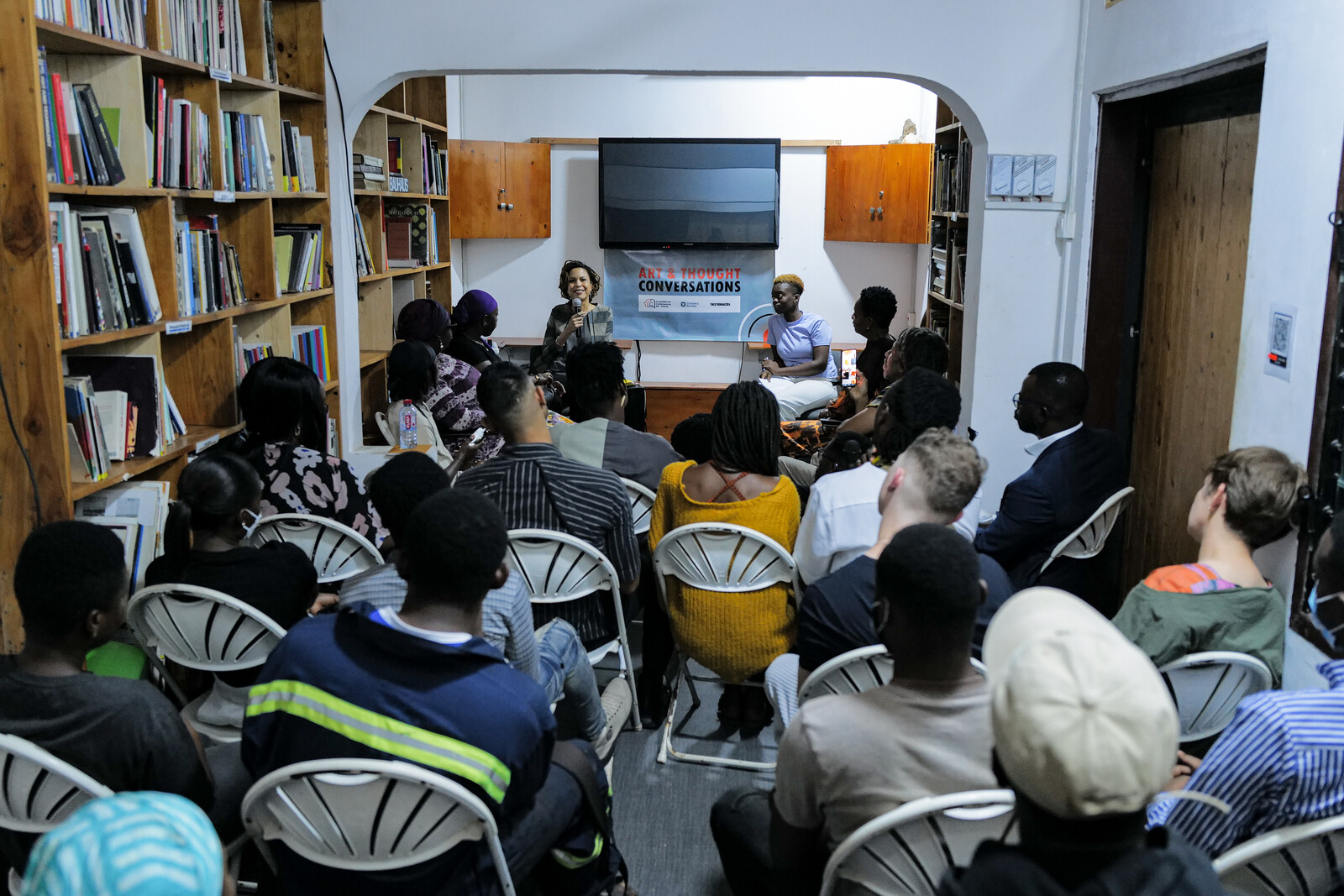
Art & Thought Conversations with Ebony Coletu and Bianca Manu, 2022. Photo: Francis Kokoroko.

Kofi Dawson’s impression of the FCA Office and Library after flooding in 2015. Photo: Adwoa Amoah.

Billie McTernan, “A collection of a thousand rains,” 2021, an exhibition as part of her MFA project shown at FCA. Courtesy of the artist.
FCA Ghana Office and Research Library, 2023. Photo: Abbey IT-A.
BA-J: What is FCA’s position within this configuration? I am asking specifically about your organization of projects that keep human traffic moving in and out of these spaces while also designing programs that index these changes and make them visible to publics?
AA: One of the things that come to mind rather easily is a particular moment, when a group of up to fifteen old Mahogany and Neem trees that used to provide excellent shade within one of the roundabouts located between the Togo Embassy, the British Ambassador’s residence, and the New Horizons Special School, were cut down under the pretext of beautification of the city, during the Ghana at Fifty celebrations (in the Greening Ghana project). This outrageous act led to a public protest with a site-specific exhibition and installation “Saving Accra’s Roots,” organized by FCA at the very site, the roundabout, where the trees had been cut. It brought a lot of attention, both physically and in the media at the time.
ABA: FCA and its collaborators led the symbolic act of replanting some new trees there.
BA-J: Are those the ones that are there now, alongside the cement sculptures that were erected by the Greening Ghana Project?
ABA: Well, we can’t tell now exactly if it was those very trees that we planted that are there today.
BA-J: But we can say that FCA has always had their hands in projects that have to do with urban space, architecture, art, and the building or organization of public and cultural space.
ABA: We can say that, yes. Some of these interventions shifted the direction of artists’ practices. Here I will highlight the mural and graffiti artist Mohammed Awudu (Moh), who is committed to using his art to influence behavioral changes in his community in Nima. Moh was one of the artists who worked with FCA on the “Graffiti & Street Art Project” in 2012, the objective of which was to create a museum on the first floor of the Brazil House dedicated to the Tabom community and to tell a story of the Tabom people through graffiti on the walls of the Brazil House and its surrounding area. The Tabom people are an Afro-Brazilian community of former slave returnees who settled in Otublohum in Jamestown. This was in partnership with the Brazilian Embassy in Ghana.4
AA: When we organize these public or community engagements with artists, we create make-shift artists’ studios in the middle of a city square or public meeting grounds. The entire community can come participate in painting murals, making objects, creating sculptures. One of the intentions, really, was to demystify the “art making” process. Often people would say: “I can’t draw or paint.” This was a time for people to try their hands on creating something. It is commonplace now for people to sign up for paint and sip events. Many artists who would otherwise hide in their studios painting or sculpting away extended their practice to include community engagement.
ABA: In Akanmaje, a community within Jamestown in Accra, for instance, community youth worked together with the artist Joseph Kola to build a metal sculpture at one of their public meeting places, where a mural painting project was taking place. The sculpture still sits in the community till today.
BA-J: These projects really challenged artists to move out and meet the people, whose hustle and bustle formed the pulse of their own work, literally. And to become even more embedded within their urban contexts. Can you speak to some of the details, using one or two projects as examples, of how the FCA has executed collaborations across the Ghanaian and international art scenes?
ABA: In 2022 FCA, Ghana collaborated with The Line in London on its Longitudinal Dialogues: Cultural Conversations on the Meridian project, which took The Line’s location on the Greenwich Meridian as a starting point for global cultural exchange. The project’s first phase connected London and Accra and presented creative responses to sustainability, plastic pollution, and climate change. Workshops were delivered at six primary schools in each city, with around 600 school children participating in the program. The schoolchildren used discarded plastic and recyclable materials to create masks inspired by the work of Ghanaian artist Serge Attukwei Clottey, who had been commissioned to create a sculpture on The Line. In some related projects, we’ll have women with babies on their backs, pupils who have returned home from the school day, or young adults who showed some interest jumping in and trying their hands at painting together with the artists. But in this particular case, it was the creation of masks.
AA: We have a long-standing partnership with The Writers Project of Ghana on their annual literary festival, Pa Gya. For three days writers, poets, academics, editors, and many other literary practitioners from Ghana and all over the world meet in Accra to share their work. There are usually book launches, a book fair where authors and publishers sell their work, and spoken word performances as well. Over the years, the festival has grown to include art talks, art and literary exhibitions, and film screenings, with FCA becoming one of the festival sites and facilitator. And as you mentioned earlier Bernard, in late 2022, FCA was also invited by the ifa Gallery in Stuttgart as part of the OtherNetwork project, where we curated an exhibition titled “If we’re happy in our dreams, does that count?” Inspired by The God of Small Things, a novel by Arundhati Roy, works of six Ghanaian artists explored the concepts of urban space and the multi-layered pasts that connect the cities of Accra and Stuttgart. The artists also explored ideas of the city as a place, myth, and agent of fiction, and reframed questions of belonging.
BA-J: Fatric, since you were part of the show, can you briefly talk about your work?
FB: I proposed to present an installation of a collection of children’s scribbles and prints on calico, a sound composition made from local and improvised musical instruments, and a video of the process, all of which was to be experienced as one work. I worked with children from Jamestown, Accra, and children from Kinder-und Familienzentrum Rosenstein in cooperation with Jukus Jugendkunstschule & Kreativwerkstatt in Stuttgart.
BA-J: Can you talk generally about your engagements with the FCA over the years? This has not been your first project with them.
FB: My particular involvement with FCA Ghana over the years has been very fruitful. FCA is a group I consider as family. I joined immediately after art school in 2007. I was new in Accra and was doing my National Service at the National Film and Television Institute (NAFTI), which is located in Cantonments. This was the time that the foundation was establishing its place in the Ghanian art scene and beyond. The foundation dared to take on lots of experimental projects to test ideas and propositions of younger artists. I was fortunate to have met such interesting individuals like the late Prof. Joe Nkrumah and Virginia Ryan, the late Atta Kwami (whom I knew already from Art School, at KNUST), and the late Bisi Silva. It was at FCA that I met Nii Noi Nortey, with whom I have done many experimental collaborations, including the piece I made in Stuttgart. I also met Serge Attukwei Clottey, and of course, you Adwoa and Ato. With the strategic position of the foundation, there was a lot to learn from collaboration with individuals and institutions, which enhanced my inter-personal relations and institutional engagement skills. Members of the foundation are always very supportive in terms of giving feedback on one’s practice. FCA has also always supported artists with resources such as literature for referencing, technical help, and advice. All these experiences have defined who I am as an artist today.
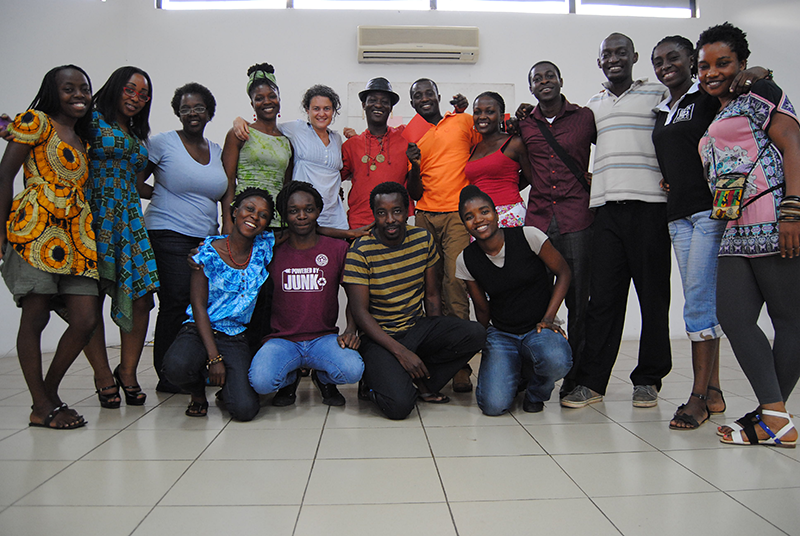

Asiko 2013 with Bisi Silva at the W. E. B Dubois Centre in Cantonment, Accra. Photo: FCA-GH Archives.
BA-J: The FCA has also been a place of internship for a lot of young people who wish to work within the arts. Can you comment briefly on this?
ABA: In the last two decades, we have consistently served institutions and individuals who seek research opportunities or hands-on experience to complement their academic activities, or as an introduction into finding their place into the art world. Through these opportunities, we have collaborated with institutions such as iKANDO (2004–2010), the Department of Painting and Sculpture at the Kwame Nkrumah University of Science and Technology (2000–current), and New York University Accra City Campus (2004–current).5
BA-J: Your collaborations are indeed multidirectional. Yet the relation to local urban contexts is always present.
AA: Yes, throughout our collaborations with institutions and individuals, the city has always been the primary context for artists’ work.
BA-J: Yes, and the focus has not only remained on the experiences of adults alone. Children and younger people have remained a focal point of FCA’s activities over the years. Is there any update on this position? What are your achievements in that area, and which bodies do you continue to engage with in that respect? I know you’ve created interventions in which you have worked particularly with the help of architects who have designed and executed projects in public parks and market spaces, where children have been the focus. Here, I am thinking about what you’ve done at the Mallam Atta Market in Accra, the Mmofra Place in Dzorwulu, and the community park in Teshie-Nungua.
ABA: The Mmofra Foundation project, comes off of the “Playtime in Africa” project that was originally conceived by Efua Sutherland, of blessed memory, who was a renowned playwright and a life-long children’s rights advocate. As part of the Playtime project, a park was meant to have been developed for children within the city of Accra to be able to play and learn, or really to learn through play. So, when a bigger location in the center of Accra, near the National Theater, did not receive much commitment from the government, the Mmofra Foundation used a property that they owned and developed a playground that is currently known as Mmofra Place in Dzorwulu, which is slightly off-center in Accra. This project was done with the support of Efua Sutherland’s family and some members of the community. But I have to say, the space does not cater to what a “normal” playground would have. Instead of installing equipment and gadgets using fixed western standards, we were inspired by how children themselves innovate with objects, and the design thinking for the equipment followed what children had been observed to do.
AA: The spatial design is more driven and informed by how children play, than how we as adults prescribe play spaces for children
BA-J: So, you worked together with artists and architects?
AA: Yes, we’ve worked with architects like Namata Serumaga-Musisi, Ralph Sutherland, and Mae-Ling Lokko, to name a few. A number of other people have come in to do one project or another, like Fatric…
BA-J: Yes, Fatric, you have also worked a lot with children. You also work in the context of a school, where you teach art to children. Can you speak to this particular interest of yours?
FB: The world of children is full of imagination and possibilities. If I had my own way, all children will be given access to resources for them to creatively express themselves as much as possible. I spend most of my time with children. I am especially amazed at children between the ages of 4–10, when in their world everything is possible. For the project I did in Stuttgart, I was interested in working with scribbles, which I see as the beginning of a child who is making an entry into identifying language and communication. I wanted to enter into this same world through the composition of sounds and see how a particular sound or series of sounds could be interpreted through scribbles. In retrospect, I think I didn’t play enough as a child, so as part of my practice, I allow myself room to answer the question “what if?” I like to experiment like a curious child, collecting things and trying to figure out the outcome.
BA-J: Coming back to FCA, after having functioned as a rallying point for artists with diverse approaches, what plans are there for the future? Is there any drive towards re-positioning in the few years to come?
ABA: We will continue to function as a rallying point for artists, catering to their needs as they come, but we also plan to position ourselves well enough to provide the much-needed financial support required to pursue more ambitious projects. A more permanent space to ground all the work done in the last twenty years is being pursued. We are talking with our collaborators, and anybody who is interested in helping us acquire a permanent place is welcome to do so. But we are certain that when the time comes to solicit help, the wider community will help make this happen. I’m basing my hopes on when, as a result of some freak floods in Accra in 2015, we lost our library and a section of our building. Many well-wishers came to our aid, and in a couple of years, we were back on our feet.
ABA: But just as we were able to move back into our physical office, in January 2020, Covid-19 hit, and Ghana, like everywhere else in the world, went into lockdown just two months later. At this point we had no option than to consider the virtual space more, just as many others in the world over were beginning to do. This approach to meeting became a welcome decision. We will continue along this path to expand our network, because the virtual possibility also unearths another kind of potential. For now, anybody who is interested in our work, art and artists in general, can consider themselves as members.
AA: At the same time, in Ghana and elsewhere, we will continue to make our gatherings happen.
Artists who participated in and benefited from Global Crit Clinics include Fatric Bewong (Ghana), Violet Nantume (Uganda), Mimi Cherono Ng’ok (Kenya), Tijay Mohammed (Ghana, USA), Serge Attukwei Clottey (Ghana), Jeremiah Quarshie (Ghana), Stary Mwamba (Zambia), Peter Nii Narku Thompson (Ghana, USA), and Tejuoso Olanrewaju (Nigeria), just to mention a few.
Critlab is run by the Exit Frame Collective in partnership with the FCA, Ghana, blaxTARLINES KUMASI, Savannah Centre for Contemporary Art, Tamale, and the KNUST Museum.
The Chale Wote Street Art Festival was founded with other institutions and artists, including Rita Garglo and the No Limit Charity Organization, Ama van Dantzig and Dr. Monk, and Serge Attukwei Clottey and the Attukwei Foundation.
The other artists involved were Ian Quhachi, Kwabena Danso, Kwabena Adjei, Steven Zion from Ghana and Binho Ribeiro and Alexandre Keto from Brazil.
Some of our interns and volunteers over the years have included: Adjo Kisser, Gideon Asma, Kimathi Calistus Agbanu, Isaac Tettey Abbey, Franklin Yohuno, Julia Neal, Ruti Talmor, Adam Vowles and many, many more.
Interdependence is a collaboration between e-flux Architecture and OtherNetwork, a project by ifa (Institut für Auslandsbeziehungen) together with cookies.
